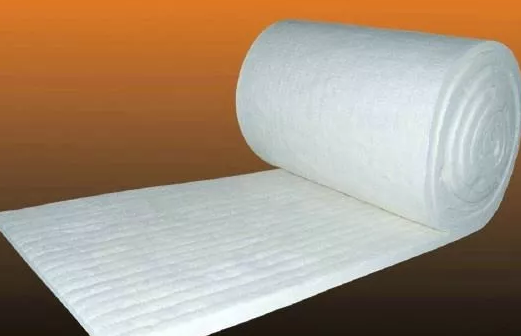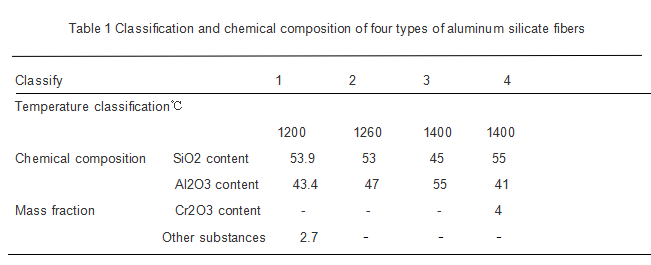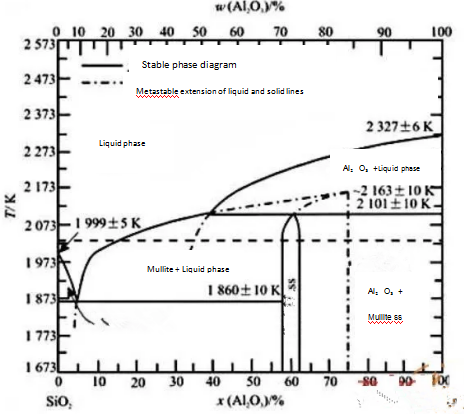Ceramic fiber porous insulation material can form a stable structure with only a small amount of material (fiber). Compared with ceramic pore insulation material, ceramic fiber insulation material is light, porous, low in thermal conductivity and specific heat capacity. Large features and can withstand very high loads. This material has been used in many fields such as filtration separation, thermal insulation, biomedicine, and composite materials. The reusable thermal protection structure represented by ceramic fiber material is widely used in the thermal protection system of various advanced aircrafts at home and abroad, and has important application value and development prospects.

Ceramic fibers can be divided into two categories: non-oxide ceramic fibers (such as SiC fibers, C fibers) and oxide (including composite oxide) ceramic fibers (such as aluminum silicate fibers, Al2O3 fibers).
1. Non-oxide ceramic fiber
(1)Silicon carbide fiber. Silicon Carbide (SiC), commonly known as silicon carbide and carbon silica, is a synthetic compound that is covalently bonded. It can be prepared by chemical vapor deposition, carbothermal reduction, powder sintering and precursor conversion. Pure silicon carbide is colorless and transparent, and silicon carbide used in the industry is often light green or black because it contains free iron, silicon, carbon and other impurities.
Because silicon carbide has good high temperature characteristics, such as oxidation resistance, high temperature strength and stability, good thermal conductivity, low density, low expansion coefficient, and low creep, it can be used as a combustion chamber for high temperature gas turbines. High temperature nozzles, turbine blades, etc. Due to its high thermal conductivity and good insulation properties, silicon carbide can be used as a high-temperature heat exchanger in metallurgical industrial furnaces, as well as substrates and packaging materials for large-scale integrated circuits. With its high hardness, wear resistance and acid and alkali corrosion resistance, mechanical sealing materials such as sliding bearings, valve discs, fan blades and corrosion-resistant pipes can be prepared in the mechanical and chemical industries.
Silicon carbide has not only good physical properties, but also excellent chemical properties. In a non-oxygen atmosphere, only 5% of silicon was contained in the gas phase on the surface of silicon carbide at 2300℃. However, when silicon carbide was exposed to oxygen at 1000℃, the surface began to oxidize, but silicon carbide could form SiO2 protective film to prevent the oxidation reaction from continuing.
(2)Carbon fiber. The carbon fiber refers to a fibrous carbon material which is heated to 1000 ° C or higher by an organic fiber in an inert gas to form a fibrous carbon material having a carbon content of 90% or more. Carbon fiber is a new type of inorganic material with a density of 1.5-2g/cm3, which is 1/4 of the density of steel, 1/2 of the density of aluminum alloy, and 4 times to 5 times stronger than steel. The thermal expansion coefficient is small, and the thermal shock resistance is good. It suddenly drops from a high temperature of several thousand degrees Celsius to a normal temperature and does not burst, and has good lubricity and electrical conductivity. Carbon fibers are chemically similar to carbon, are inert to general alkalinity, and do not embrittle at liquid nitrogen temperatures. In a non-oxygen environment, even at a high temperature of 3000 ℃, it does not melt, but in an air atmosphere, when the temperature is higher than 400 ℃, significant oxidation occurs, and CO and CO 2 are generated. Therefore, carbon fiber can greatly reduce the structural weight of the component and improve the technical performance, making it widely used in aerospace vehicles.
Depending on the raw materials used, carbon fibers can be classified into polyacrylonitrile-based carbon fibers, pitch-based carbon fibers, cellulose-based carbon fibers, and phenolic-based carbon fibers. The most common carbon fibers used are polyacrylonitrile carbon fiber and pitch carbon fiber.
2. Oxide ceramic fiber
(1)Aluminum silicate fiber. The shape and color of aluminum silicate fiber is similar to that of cotton. It is an amorphous ceramic fiber mainly composed of alumina and silica, and sometimes contains a small amount of iron oxide, titanium dioxide, calcium oxide and the like. According to the composition of the substance and the content, it can be divided into four categories: standard (ordinary) aluminum silicate fiber, high-purity aluminum silicate fiber, high-purity aluminum-containing aluminum silicate fiber and high-purity zirconium aluminosilicate fiber. The content of the components is shown in Table 1-2.

Aluminum silicate fiber has a diameter of 1-10μm and a length of 5-25cm. It has good temperature resistance, heat insulation and sound absorption, and has low heat storage, low thermal conductivity and strong resistance to mechanical vibration. The service temperature can reach 1200°C. The density is only 0.096-0.128g/cm3. After the addition of CrO2, since CrO2 prevents crystal precipitation and growth at the contact portion between the fibers, the high-temperature shrinkage resistance of the fiber can be improved, and the use temperature reaches 1400 °C. The aluminum silicate fiber composite material can be made into the shape of carpet, felt, paper and plate. It has been widely used in the thermal insulation of thermal energy equipment such as chemical industry and machinery, and the thermal insulation layer of rocket engine parts.
(2) Quartz fiber. Quartz fiber refers to high purity specialty silica glass fiber with a magazine content of less than 0.1% and a fiber diameter of 0.7-15 μm. It has high heat resistance, long-term stable use temperature of 1050 ° C, and instant temperature resistance up to 1700 ° C.In addition, quartz fiber has corrosion resistance, high strength retention at high temperature, dimensional stability, good thermal shock resistance, high chemical stability, and excellent electrical insulation properties, dielectric constant and dielectric loss. The coefficient is the best among all mineral fibers and is much cheaper to produce than silicon carbide fibers. Therefore, quartz fiber has an important use in the defense military and aerospace industries and can be used to manufacture aerospace thermal protection systems.
Quartz fibers are classified into continuous quartz glass fibers and quartz glass wool. Continuous quartz glass fiber refers to a long fiber obtained by drawing an external force after the quartz glass is melted. Generally, the diameter of the monofilament is 3-10 μm, and it can be processed into quartz glass fiber yarn, cloth, and the like. Quartz glass wool refers to a kind of long and short quartz glass fiber obtained by blowing a quartz glass melt by a high-pressure airflow, and its shape is fluffy, similar to cotton wool. Generally, ultrafine cotton, which has a fiber diameter of less than 3 μm, is called fine cotton having a diameter of 3-5 μm.
(3) Mullite fiber. Mullite is the only binary compound which can be stably present at normal temperature and pressure in the binary system of silica and alumina. The chemical formula is 3Al2O3·2SiO2, and its phase diagram is as shown in Figure 1.

Figure 1 Mullite material phase diagram
Mullite fiber is a polycrystalline fiber with a main crystal phase of mullite crystallites. It is the only stable phase in the binary system of silica and alumina. Its activity is low and its recrystallization ability is poor. The stone fiber has good high temperature resistance and can be used up to 1500 ℃. However, when the temperature is higher than 1500 ℃, the grain will grow and lose its high temperature mechanical properties. When the temperature reaches about 1830 ℃, Will quickly decompose into alumina and liquid phase. The mullite fiber expands evenly when heated, has excellent thermal shock resistance stability, low thermal conductivity, is not easy to creep at high temperature, and can not only maintain good elasticity, but also has small shrinkage, and the material itself has good chemical stability. It is not susceptible to corrosion, so it is widely used in various high-temperature products and thermal protection systems as a new ultra-light high-temperature heat-resistant fiber material. However, the normal temperature mechanical properties of mullite fiber are not good, which has become a major obstacle to the practical use of the material.
(4) Alumina fiber. Alumina fiber is a kind of polycrystalline ceramic fiber, which has many forms such as long fiber, short fiber and whisker. It mainly contains Al2O3, and sometimes contains a certain amount of additives such as silica, boron nitride, zirconia, iron oxide, magnesium oxide and the like. The alumina fiber has a diameter of 10-20 μm and a density of 2.7-4.2 g/cm3, and has high mechanical properties, tensile strength of 1.4-2.45 GPa, and tensile modulus of 190-385 GPa.
It has good chemical resistance, oxidation resistance, high temperature resistance, high chemical stability and low coefficient of thermal expansion, melting point of 2050 ° C, can be used at 1500 ° C for a long time.
Alumina short fibers are mainly used for high temperature insulation materials, long fibers are used for reinforcing composite materials, and whiskers have high strength and some special magnetic, electrical and optical properties, which are used in functional materials. Alumina fiber has good surface activity and is easy to be compounded with base materials such as metal and ceramics. Combined with its high use temperature, it has been widely used in general industrial and high-tech fields. It can be used in high temperature furnaces and thermal engineering. Equipment, nuclear reactors and thermal insulation materials for the space shuttle. The United States uses alumina fibers as insulation panels on the Space Shuttle Columbia. When the space shuttle is flying in the atmosphere, the insulation panels prevent heat from entering the heat shield through the gap between the insulation panels. Alumina fiber has important strategic significance and great commercial value in military and aerospace, attracting many countries to invest a lot of manpower, material resources and financial resources for research and development and utilization. However, the alumina fiber has a high density and a high thermal conductivity, which limits its further application.

